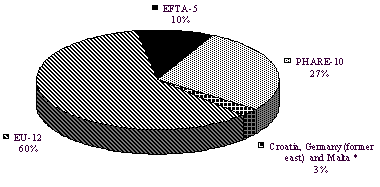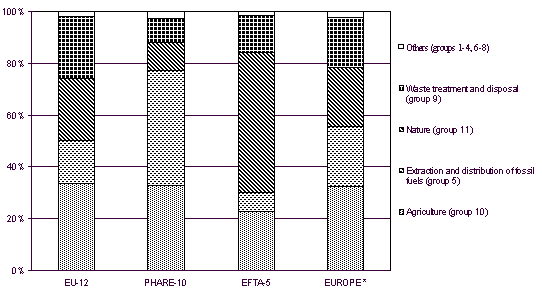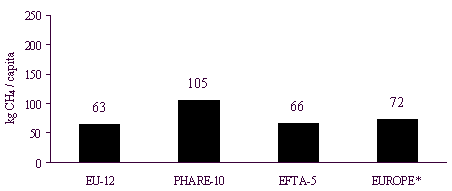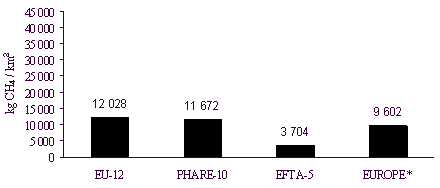4. METHANE - CH4
4.1 CH4-emissions by countries
The 1990 annual total CH4-emissions for
EUROPE were estimated to be 45 million tonnes. These emissions broken down by EU-12,
EFTA-5 and PHARE-10 countries are shown in figure 4.1. The largest contributor were the
EU-12 countries with 60%, second largest the PHARE-10 countries with 27%. The EFTA-5
countries contributed 10% and Germany (former East) and Malta 3%.
Figure 4.1: Contribution in % to the EUROPEAN total
CH4-emissions

*) Croatia not yet
available
Figure 4.2 shows the relative contribution of
individual countries to the total of 45 million tonnes. In 1990 the largest contributing
countries were Poland (13%), Greece (12%) and Germany (former West; 11%); the smallest
contributing countries were Malta (0.02%), Luxembourg (0.06%) and Slovenia (0.3%). These
differences are due to different size of population, different per capita emissions (see
also paragraph 4.3) and differences in
emissions from natural sources.
Figure 4.2: Contribution in % of each country to the
EUROPEAN total CH4-emissions

*) Croatia not yet available
4.2 CH4-emissions per group
One third of the CH4-emissions for EUROPE
resulted from agriculture (group 10) in 1990. Group 11 (nature) and group 5 (extraction
and distribution of fossil fuels) both contributed 23%. Group 9 (waste treatment and
disposal) produced 19% and group 2 (commercial, institutional and residential combustion)
contributed only 1% to the total CH4-emissions of EUROPE. In contrast to other
pollutants the groups 1 (public power, cogeneration and district heating), 3 (industrial
combustion), 4 (production processes), 7 (road transport) and 8 (other mobile sources and
machinery) are not relevant for CH4-emissions.
The split of the CH4-emissions into
groups for EU-12 countries is quite similar compared to the split for EUROPE with the
exception of the smaller contribution of group 5 (extraction and distribution of fossil
fuels) with 16% for EU-12 countries. In the PHARE-10 countries the contribution of group 5
(extraction and distribution of fossil fuels) is 44% and thus significant higher than its
contribution in EUROPE. In the PHARE-10-countries the groups 9 (waste treatment and
disposal) and 11 (nature) produced 9% and 11% of the CH4-emissions; this is
much lower than the contribution of these groups in EUROPE, in the EU-12 countries and in
the EFTA-5 countries. In the EFTA-5 countries more than half of the CH4-emissions
were attributed to group 11 (nature).
The differences of contributions especially of the
main sourcegroups 10, 11, 5 and 9 to the total emissions are larger between countries than
these groups (see also table 4.1). The relative contribution of
the CH4-emissions of group 10 ranges from 76% (Ireland) to 7% (Greece), of
group 11 from 83% (Greece) to 0% (Belgium, Wallonie region and others), of group 5 from
56% (Romania) to 0% (Sweden and others) and of group 9 (waste treatment and disposal) from
80% (Malta) to 0% (Lithuania and others).
However it is evident already from these differences
in the relative contribution of source groups to a countries total emissions that
strategies for reduction of CH4-emissions need individual solutions as well as
common elements.
Figure 4.3: Contribution in % of source groups to
the EUROPEAN CH4-emissions

*) Croatia not yet available
4.3 CH4-emissions
per capita
Only anthropogenic emissions are expected to be
related to population for these calculations. Therefore group 11 (nature) has been
excluded.
For EUROPE the average CH4-emissions per
capita were 72 kg/capita. Compared to this number the per capita CH4-emissions
were 13% smaller for the EU-12 countries with 63 kg/capita, 8% smaller for the EFTA-5
countries with 66 kg/capita and 46% larger for the PHARE-10 countries with 105 kg/capita.
This comparison is also shown in figure 4.4 and table 9.
Again the differences are much larger if individual
countries are compared: the largest CH4-emissions per capita were estimated for
Ireland (226 kg/capita) and the next largest ones for Poland (151 kg/capita) and Czech
Republic (141 kg/capita); the smallest per capita emissions for CH4 were
calculated for Portugal (25 kg/capita), Malta (26 kg/capita) and Belgium, Flemish region
(28 kg/capita). Figure 4.6 shows the countries ranked according their per capita
emissions. The smallest per capita emissions is a factor of 9 smaller compared to the
largest number.
Figure 4.4: CH4-emissions per capita for
EUROPE

*) Croatia not yet available
Figure 4.5: CH4-emissions per capita for
individual countries

*) Croatia not yet available
4.4 CH4-emissions per km2
The emissions per km2 have been
calculated from the total emissions, the emissions of group 11 (nature) having been
included in this case.
For EUROPE the average CH4-emissions per
km2 were estimated as 9 602 kg/km2. Compared to this number the per
km2 CH4-emissions were 25% larger for the EU-12 countries with 12
028 kg/km2, 22% larger for the PHARE-10 countries with 11 672 kg/km2
and 61% smaller for the EFTA-5 countries with 3 704 kg/km2. This comparison is
also shown in figure 4.6 and table 10.
Figure 4.6: CH4-emissions per km2
for EUROPE

*) Croatia not yet available
Again the differences are much larger if individual
countries are compared; the largest CH4-emissions per km2 were for
Greece (41 738 kg/km2) and the next largest ones for Malta (28 611 kg/km2)
and the Netherlands (25 079 kg/km2); the smallest emissions per km2
for CH4 were for Norway (868 kg/km2), Finland (2 930 kg/km2)
and Lithuania (4 090 kg/km2). Figure 4.7 shows the countries ranked according
their CH4-emission per km2. The differences in the emissions per km2
between countries are much larger compared to the per capita emissions. The smallest
number being 48 times smaller than the largest number.
Figure 4.7: CH4-emissions per km2
for individual countries

*) Croatia not yet available
Table 4.1: Methane emissions
per country and group








Document Actions
Share with others